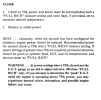Hi all, new here. Pretty impressive how much knowledge there is available on these boards. Looking forward to tapping into it. Thanks in advance. I am a low time pilot looking to get my high performance checkout soon. Lots of XPlane playing has set me up with likely bad habits but a collection of knowledge that has left me with gaps that I now need to fill in. I recently took a flight with an friend who let me ride along in the back seat of their 182M just for fun. I tried to pay attention and it raised a couple questions for me. Hoping to be enlightened a little bit here.
First, in the climb I noticed manifold pressure gradually drops from the maximum continuous 23 inches set at the start of the climb. I'd never thought about this before but that would mean needing to continually increase throttle in the climb to maintain max continuous power (up to the altitude where the POH directs lower than 23 inches as the max continuous for cruise). Is it correct that you'll add throttle to maintain 23 inches during the climb to cruising altitude, or should you set it at 23 inches at the start of the climb and then leave it? I've never heard of the need to increase throttle during the climb. Usually it's seems like youre told to set it and then just lean the mixture in the climb. No adjustment to throttle.
Second, the CHTs were running at 300 or a little under. My buddy said this was normal. There are a million different search results about proper CHTs and all of them are referencing temps running significantly higher than this for an O-470. Is there any risk associated with LOW CHTs? I get the risk of high CHT temps, but nothing every talks about a low CHT. What could be the cause? Is this actually low? What's normal?
In the end, I know a lot of questions will be answered by a CFI when I jump into training for the high performance endorsement. Just want to start my familiarization as early as possible.
Any general tips on engine management in high performance planes would also be appreciated. At some point I'd like to get my commercial license and starting my knowledge growth early seems like a good idea. Thanks all.
First, in the climb I noticed manifold pressure gradually drops from the maximum continuous 23 inches set at the start of the climb. I'd never thought about this before but that would mean needing to continually increase throttle in the climb to maintain max continuous power (up to the altitude where the POH directs lower than 23 inches as the max continuous for cruise). Is it correct that you'll add throttle to maintain 23 inches during the climb to cruising altitude, or should you set it at 23 inches at the start of the climb and then leave it? I've never heard of the need to increase throttle during the climb. Usually it's seems like youre told to set it and then just lean the mixture in the climb. No adjustment to throttle.
Second, the CHTs were running at 300 or a little under. My buddy said this was normal. There are a million different search results about proper CHTs and all of them are referencing temps running significantly higher than this for an O-470. Is there any risk associated with LOW CHTs? I get the risk of high CHT temps, but nothing every talks about a low CHT. What could be the cause? Is this actually low? What's normal?
In the end, I know a lot of questions will be answered by a CFI when I jump into training for the high performance endorsement. Just want to start my familiarization as early as possible.
Any general tips on engine management in high performance planes would also be appreciated. At some point I'd like to get my commercial license and starting my knowledge growth early seems like a good idea. Thanks all.


